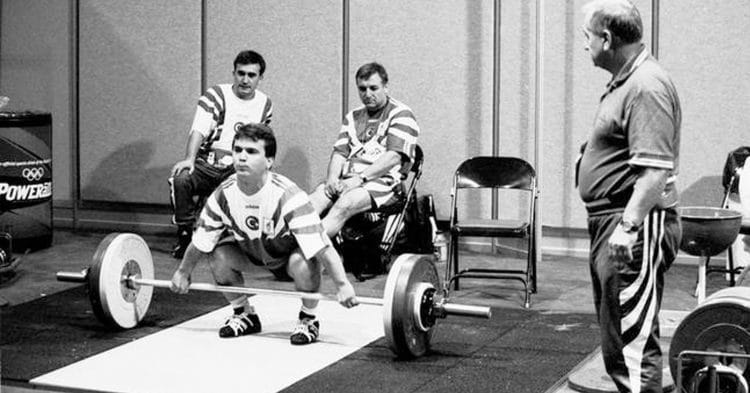The Bulgarian Method: Defined & Simplified
A Controversial Method That Shouldn't Be
The Bulgarian Method [BM]
The method of strength training that is responsible for developing 12 Olympic champions, 57 world champions, and 64 European champions in the sport of Olympic Weightlifting for the country of Bulgaria is known simply as: The Bulgarian Method.
The Bulgarian Method is the brainchild of the Bulgarian weightlifting coach Ivan Abadjiev - a true strength practitioner. Coach Abadjiev was not just a champion coach but also a champion weightlifter himself. He was a doer, but unfortunately, he was not an author, and because he himself did not define the method that emerged from Bulgaria’s successful quest to be the most dominant weightlifting team in the world, there are a lot of false misconceptions surrounding the method. We will attempt to clear some of those misconceptions.
The Bulgarian Method Works
Firstly, understand that any argument that the Bulgarian Method does not work is total bullshit. This training method developed 133 champion weightlifters - an astronomical number to consider. Those results and reality enable us to know with certainty that the Method does work. All arguments that the Method does not work exist outside of reality, in thought experiments in the brains of critics who, if you asked the critic - have you ever tried the Method themselves? Universally their response would be: no.
Bulgaria’s Point B
At Absolute, we have introduced and defined what our Point B is, enabling us to program, organize and manage an athlete with the sole aim to acquire and sustain an optimal physical state - but what was Bulgaria’s Point B?
Bulgaria’s Point B was to program, organize and manage the training in a manner that developed and then generated champions in the sport of Olympic Weightlifters - which history enables us to know it did such that.
The Bulgarian Method Functions like an Algorithm
“An algorithm is a methodical set of steps that can be used to make calculations, resolve problems, and reach decisions. An algorithm isn’t a particular calculation, but the method followed when making the calculation.” — Yuval Noah Harari
With the above definition as the lens, it becomes easy to see that our understanding of the Bulgarian Method was simply training inputs that functioned as an algorithm the Bulgarians utilized to become, at one point in time, the most dominant weightlifting country on the planet.
The Bulgarian Algorithm
At its core, the Bulgarian Method was to have the athletes perform the various Olympic lifts - i.e., snatch, clean and jerk, and front squat, utilizing near maximum to maximum weights (~90 - <100 % of 1 rep max).
In addition to the maximum efforts required, the lifts would also be performed multiple times a day, around two to four times a day, with adequate rest/breaks between the training. The lifter will perform the daily near maximum to maximum lifts six days a week, leaving one day of rest per week.
A Simple Algorithm Defined By Training Science
“Make everything as simple as possible, but not simpler.” — Albert Einstein
Adhering to Einstein's advice will enable us to utilize this algorithm with the intent to establish Point B. Quite simply, the algorithm is to combine high specificity with high frequency performed at the appropriate, stimulating intensity.
High Specificity
High specificity means the training work (i.e., exercise selection) performed by the trainee has been selected by the coach (i.e., programmer) to elicit highly specific training effects.
In the case of the Bulgarians, they trained with the specific intent to win World and Olympic championships in the sport of Olympic Weightlifting. To support that intent to get to their Point B, the exercises that were selected were the exact lifts of the sport or lifts that were very similar in nature.
This fact underscores that the programming of training inputs with high specificity meant that Abadjiev was adhering to the Biological Law of Specificity, also known as the SAID Principle. The SAID principle is an acronym for Specific Adaption to Imposed Demands.
High Frequency
The training demands were done with high frequency - with that frequency being daily, multiple times a day, six days a week. When the Bulgarians ran this algorithm, they were the only ones on planet earth training with this frequency, which is still a point of contention to this day when the Bulgarian Method is discussed. We at Absolute believe the training at this frequency is still a point of contention due to a lack of understanding of training intensity because training with high frequency isn’t necessarily a bad thing.
In fact, it is our belief that there are no negative effects of training at high frequency with a stimulating intensity multiple times a day when the training inputs and subsequent demands are highly specific.
Stimulating Intensity
The last ingredient in the Bulgarian Method algorithm is stimulating intensity. The Science and Practice of Strength Training classifies training work into 1 of 3 training intensities - stimulating, retraining, and detraining. Utilizing near maximum to maximum (~90 - <100%) weights in the lifts means the training intensity is stimulating in nature. Specific stimulating training work elicits specific training effects such that when these training effects are metabolized and absorbed, the result is training adaptation.
Stimulating Intensity Does Not Equal High Intensity
Critics of the Bulgarian Method have a massive blindspot in their understanding of training intensity. These critics falsely believe that athletes cannot specifically and frequently train at stimulating intensities. The blind spot is that these critics believe that all stimulating intensities are done at a high intensity, which is simply not true.
If strength exists on a continuum of emergence from the CNS to individual tissues as we believe it to be, strength then can be neurologically mediated or specific tissue mediated depending on the task demand. If this is the case, and we know that not all tasks are created equal, then it would make sense that the achievement of specific tasks would require different intensities and, therefore, efforts on the part of the athlete to achieve them.
Let's discuss a training scenario to prove the point that a stimulating intensity does not always equate to high intensity.
Training Scenario: We are tasked with programming training inputs for an athlete who possesses a dysfunctional shoulder joint, whereby it is difficult for them to get into overhead positions to perform any training work in this area. The dysfunctional shoulder is also carrying over to external training work in that this particular athlete is unable to push at maximal efforts, and therefore any pressing is impacted, and training has plateaued. This is important at this time as it is the goal of this athlete based on demands at the Level of Competition to increase their absolute strength.
As we have discussed in the past, possessing joint function is a prerequisite of establishing Point B for any athlete, and is related to the ability to maximize absolute strength. Therefore, this capacity must be a priority for this athlete at the expense of pushing absolute strength at this time. However, if we program the training work appropriately, we should see now that there will be no decrease in the athlete’s current absolute strength capacity.
As a result of the dysfunctional shoulder limiting access to certain areas of the athlete’s workspace, there will be carryover effects in specific tissues surrounding the shoulder joint. This will impact the connective tissue architecture of various tissues that are unable to lengthen appropriately, which will have an impact as well on the underlying muscle specific tissue. It is easy to see now that specific training work must occur at multiple levels - i.e., joint capsular space, joint workspace, connective tissue architecture, and specific muscle tissue hypertrophy to get the athlete to have a functioning healthy shoulder joint.
Doing all of this simultaneously may seem like a daunting task considering the goal of the athlete is to increase absolute strength. The fact that strength exists on a continuum of emergence allows us as the programmer to understand that to change this shoulder joint from a state of dysfunction into a state of function, as well as create the factors to change the internal ecosystem all of the training work must be stimulating in nature, but there is no way that it will all be done at a high intensity.
In this case, our high-intensity efforts will be directed toward creating the necessary capsular space to target the neurological emergence of strength. For the tissue-specific training, inputs stimulating intensities will vary depending on the intent. For example, stimulating training work that optimally stresses the connective tissue to adapt to improve the architecture as well as acquire more length is not high intensity - it is the exact opposite!
From an external training perspective, any training work done within the useable workspace will fall under retraining or detraining intensities.
Once we understand the concept of strength emergences existing on a continuum and that this is related to how there are different stimulating intensities to create the specific changes we need, it becomes clearer to see that training at high frequency is not a problem - it is the solution! More to come…






Great article!